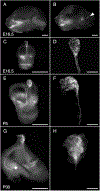Dissection of the Endolymphatic Sac from Mice
- PMID: 33843930
- PMCID: PMC8890325
- DOI: 10.3791/62375
Dissection of the Endolymphatic Sac from Mice
Abstract
The study of mutant mouse models of human hearing and balance disorders has unraveled many structural and functional changes which may contribute to the human phenotypes. Although important progress has been done in the understanding of the development and function of the neurosensory epithelia of the cochlea and vestibula, limited knowledge is available regarding the development, cellular composition, molecular pathways and functional characteristics of the endolymphatic sac. This is, in large part, due to the difficulty of visualizing and microdissecting this tissue, which is an epithelium comprised of only one cell layer. The study presented here describes an approach to access and microdissect the endolymphatic sac from the wild-type mouse inner ear at different ages. The result of a similar dissection is shown in a pendrin-deficient mouse model of enlargement of the vestibular aqueduct. A transgenic mouse with a fluorescent endolymphatic sac is presented. This reporter mouse can be used to readily visualize the endolymphatic sac with limited dissection and determine its size. It can also be used as an educational tool to teach how to dissect the endolymphatic sac. These dissection procedures should facilitate further characterization of this understudied part of the inner ear.
Figures





Similar articles
-
SLC26A4 targeted to the endolymphatic sac rescues hearing and balance in Slc26a4 mutant mice.PLoS Genet. 2013;9(7):e1003641. doi: 10.1371/journal.pgen.1003641. Epub 2013 Jul 11. PLoS Genet. 2013. PMID: 23874234 Free PMC article.
-
Ephrin-B2 governs morphogenesis of endolymphatic sac and duct epithelia in the mouse inner ear.Dev Biol. 2014 Jun 1;390(1):51-67. doi: 10.1016/j.ydbio.2014.02.019. Epub 2014 Feb 26. Dev Biol. 2014. PMID: 24583262 Free PMC article.
-
The surgical approach to the endolymphatic sac and the cochlear aqueduct in the guinea pig.Am J Otolaryngol. 1989 Jan-Feb;10(1):61-6. doi: 10.1016/0196-0709(89)90093-8. Am J Otolaryngol. 1989. PMID: 2929878
-
Mouse models for pendrin-associated loss of cochlear and vestibular function.Cell Physiol Biochem. 2013;32(7):157-65. doi: 10.1159/000356635. Epub 2013 Dec 18. Cell Physiol Biochem. 2013. PMID: 24429822 Free PMC article. Review.
-
Pathophysiologic Findings in the Human Endolymphatic Sac in Endolymphatic Hydrops: Functional and Molecular Evidence.Ann Otol Rhinol Laryngol. 2019 Jun;128(6_suppl):76S-83S. doi: 10.1177/0003489419837993. Ann Otol Rhinol Laryngol. 2019. PMID: 31092029 Review.
Cited by
-
SLC26A4-AP-2 mu2 interaction regulates SLC26A4 plasma membrane abundance in the endolymphatic sac.Sci Adv. 2024 Oct 11;10(41):eadm8663. doi: 10.1126/sciadv.adm8663. Epub 2024 Oct 9. Sci Adv. 2024. PMID: 39383236 Free PMC article.
-
CHD7 variants associated with hearing loss and enlargement of the vestibular aqueduct.Hum Genet. 2023 Oct;142(10):1499-1517. doi: 10.1007/s00439-023-02581-x. Epub 2023 Sep 5. Hum Genet. 2023. PMID: 37668839 Free PMC article.
-
AAV8BP2 and AAV8 transduce the mammalian cochlear lateral wall and endolymphatic sac with high efficiency.Mol Ther Methods Clin Dev. 2022 Jul 31;26:371-383. doi: 10.1016/j.omtm.2022.07.013. eCollection 2022 Sep 8. Mol Ther Methods Clin Dev. 2022. PMID: 36034771 Free PMC article.
References
-
- Reardon W, CF OM, Trembath R, Jan H, Phelps PD Enlarged vestibular aqueduct: a radiological marker of pendred syndrome, and mutation of the PDS gene. QJM. 93 (2), 99–104 (2000). - PubMed
-
- Eckhard A et al. Water channel proteins in the inner ear and their link to hearing impairment and deafness. Molecular Aspects of Medicine. 33 (5-6), 612–637 (2012). - PubMed
Publication types
MeSH terms
Grants and funding
LinkOut - more resources
Full Text Sources
Other Literature Sources
Molecular Biology Databases
